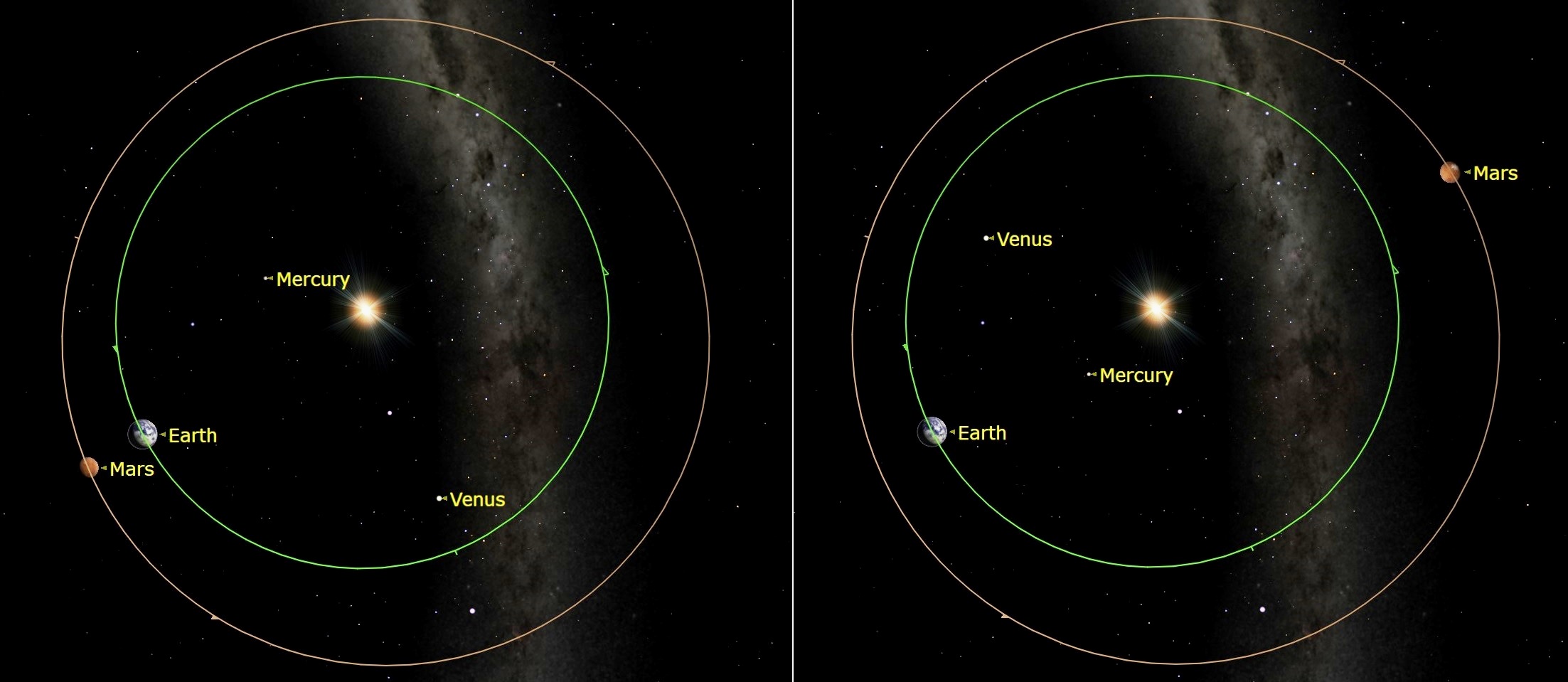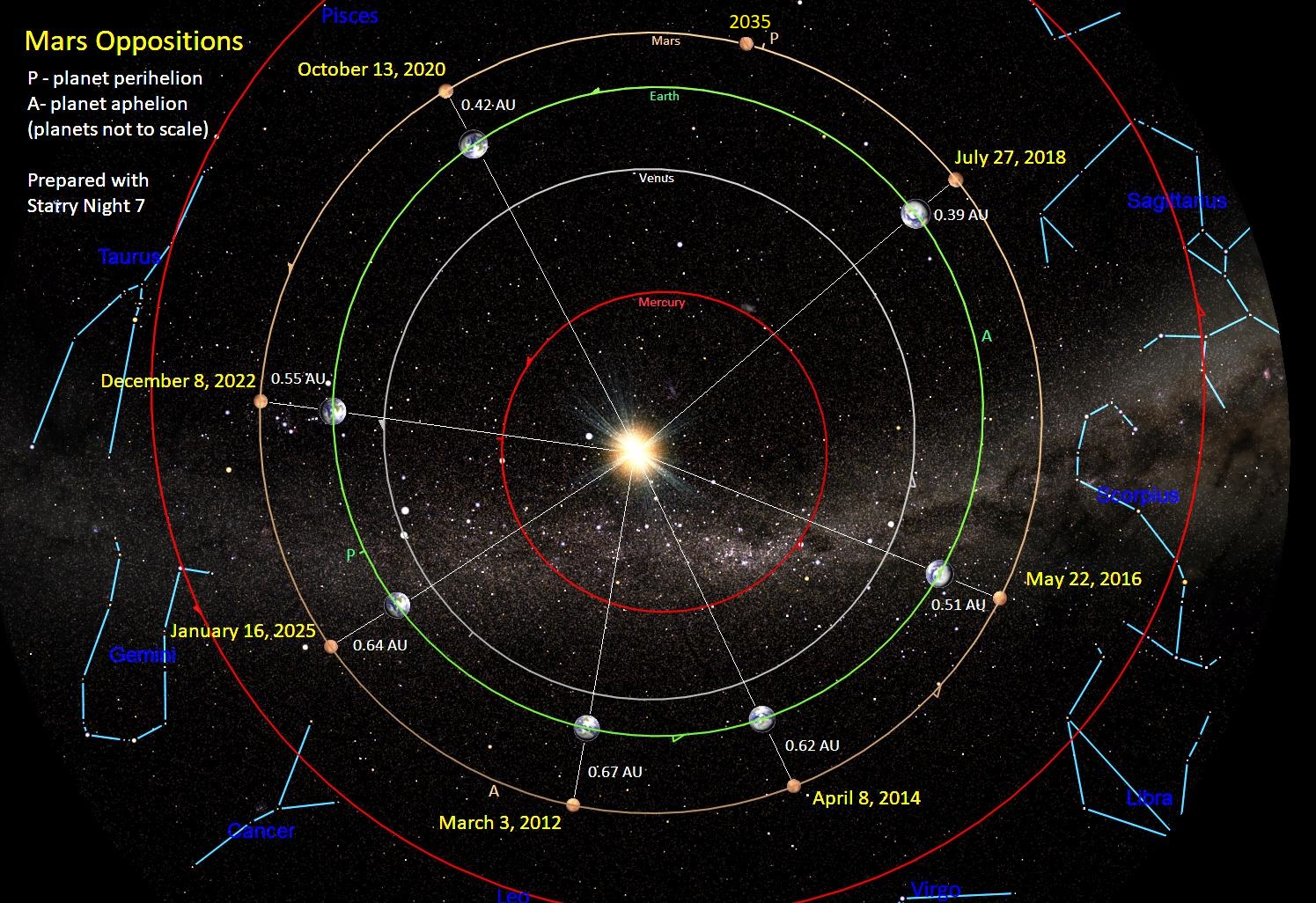Exploring Mars at Opposition using Starry Night
After months of waiting, Mars has finally taken center stage in the night sky for skywatchers all around the world!
On Tuesday morning (Oct. 6), the Red Planet was closer to Earth than it will be at any time until 2035. Next Tuesday, Oct. 13, Mars will officially reach opposition, and maximum brightness in the sky.
In the interim, virtually any size of telescope will be able to show you Mars' ruddy disk — and perhaps some surface features! Advanced software applications like Starry Night 8 are perfect for demonstrating what is happening, where to see Mars in your own sky, and what details to look for.
Amazing photos: The 'Blood Moon' eclipse and Mars opposition of 2018
What's Mars doing?
Let's break down exactly why all this is happening. Mars has an orbit that is about 50% farther from the sun than Earth's, on average. That causes Earth to complete an orbit of the sun more quickly than Mars does. In fact, Earth circles the sun almost twice in the time Mars takes to complete one orbit.
If the planets were placed at the same starting line on an imaginary racetrack around the sun (as they will be Tuesday, at opposition), when Earth returned after one lap, slowpoke Mars would be out of sight on the opposite side of the sun. When Earth has completed its second lap, Mars would be back on the same side of the sun, and a bit ahead of us along the track. To be precise, Earth passes Mars every two years and 50 days.
There's an extra twist to all this. Our orbit is fairly circular, while Mars' orbit is much more elliptical. Its distance from the sun varies quite a bit — between 128.4 and 154.8 million miles (or 206.7 and 249.2 million kilometers) — a variation of about 20%. Every 15 years or so, the geometry works out that we pass Mars while we are near aphelion (our maximum distance from the sun) and Mars is near perihelion (its minimum distance from the sun). When that happens, our two planets are much closer to one another. That happened in July, 2018. This month's encounter is almost as close, and will not be repeated until September, 2035 — when Mars will be near its perihelion point at opposition.
Breaking space news, the latest updates on rocket launches, skywatching events and more!
Planets are lowest in the sky during summer, medium-high in spring and autumn, and highest during the winter. Because this opposition is happening during autumn, Mars will climb relatively high in the sky — about 50 degrees elevation for mid-northern latitude observers. That's ideal for telescope viewing. In July, 2018, Mars climbed to only about 21 degrees above the southern horizon — too low for clear views.
You can demonstrate the relative positions of the planets using starry Night. Launch the Inner Solar System simulation in the Applications Favorites library and then tilt the view to look down on the solar system from above. By setting the date to Oct. 13, 2020, and stepping forwards and backwards one day at a time, you can see how the planets alignment varies. You can also view the July 27, 2018 and September 16, 2020 oppositions — and other less favorable ones.
Closest approach and opposition
This year, Earth and Mars are meeting about two months after Mars passed perihelion. Right now the two planets are positioned in the zone where the distance between their orbits is widening. For that reason, Mars was closest to Earth on Oct. 5-6, but will be aligned with the Earth and sun at opposition, a full week later.
During the early hours of Tuesday, Oct. 6, Earth and Mars were only 38.57 million miles apart. That's 62.07 million km, 0.415 Astronomical Units (1 A.U. is the mean Earth-sun distance), or 3.45 light-minutes distant from Earth. Viewed in a telescope Mars' maximum apparent disk diameter peaked at 22.6 arc-seconds. (For comparison, Jupiter's disk spans about 44 arc-seconds.)
At opposition on Oct. 13, Mars will be 38.97 million miles, or 62.7 million km, or 0.419 AU, or 3.49 light-minutes away from Earth. A year from now, Mars will be on the far side of the sun — at a distance of 244.5 million miles, or 393.4 million km, 2.63 AU, or 21.85 light-minutes! It's clear why we send spacecraft to Mars around oppositions!
Finding Mars in the sky
Mars is already brighter than Jupiter in the evening sky. This week, the very bright, reddish-tinted planet will be rising in the east before 7 p.m. in your local time zone. It will reach more than a third of the way up the southeastern sky by late evening, then it will climb to slightly more than half-way up the southern sky by 2 a.m. local time, and set in the west after sunrise.
Because Earth is passing between Mars and the sun now, Mars is moving retrograde, causing the planet to appear to travel backwards (westwards) compared to the narrow "V" of modest stars at the bottom of the constellation of Pisces, the Fishes. But you won't see that motion, unless you carefully note the positions of Mars and the surrounding stars over several nights.
Mars will be easy to spot in the sky on every clear night for weeks to come. It will be rising about 5 minutes earlier every night — so it will slowly shift towards the west, and remain observable until the end of May, 2021! While it does that, Earth will be pulling away from it, causing Mars to shrink dramatically in disk size and visual brightness after opposition night — but it will also become better placed for evening observing. At mid-northern latitudes, the planet will reach its maximum height above the southern horizon several hours earlier at month-end than it did in early October.
Viewing Mars in a telescope
In good binoculars you might be able to discern Mars' little round disk — but if you can get your hands on any sized telescope, you'll see much more! Because Mars' rotational period (its day) is about 38 minutes longer than Earth's, by viewing the planet over many nights you can see different parts of Mars' surface.
In fact, it would take you 41 nights of observing at the same time of the evening to see the entire globe of Mars rotate once. But since we have about 10 hours of darkness during nights in early October, you could check in on the planet at 9 p.m. and again at 6 a.m. local time, and see much more than half of its globe within a single!
Mars' Earth-facing hemisphere on Oct. 12-13 will display its bright southern polar cap — visible as a small bright, white spot near the planet's edge. Look for the dark Tyrrhena Terra, Cimmeria Terra, and Sirenum Terra regions, and the lighter-toned Amazonis Planitia and Eylsium regions. After midnight local time, the very dark, wedge-shaped Syrtis Major Planum region, the dark Tyrrhena Terra, and Sinus Sibaeus regions, and the lighter-toned Hellas Planitia region will all rotate into view.
That view of Mars will remain about the same all week. (Don't forget that your telescope will probably flip Mars upside-down and/or mirror it left-to-right.) Owners of larger telescopes can also try to see Mars' two small moons, Phobos and Deimos by hiding bright Mars outside the eyepiece's field of view.
You can use Starry Night to preview what the planet will show through a telescope. Set the date and time to when you plan to observe, then right-click and magnify Mars. Starry Night includes several skins (or Surface Image/Models) you can overlay the planet with. I prefer to right-click on Mars and select the Viking color mosaic. To identify markings you can right-click and launch the Markers and Outlines dialog box. Scroll through and select regions to label — or type the ones I mentioned above in the Filter: box and put a check mark beside them. To match the way your telescope flips the view, open the Options/Flip menu and choose the mode that matches what you see in the eyepiece.
Here are some observing tips. When viewing anything in a telescope, be patient. Look continuously, and wait for the moments of sharp clarity when the air settles down. The colored filters that come with some telescopes and eyepiece kits can enhance Mars, as follows:
- #23A Light Red — Dust clouds on Mars
- #25 Red — Ice caps and surface of Mars
- #47 Violet — Clouds on Mars
- #56 Light Green — Mars ice caps
- #58 Green — Martian ice caps, clouds and dust storms
If you find Mars appears too bright in your telescope, try using a moon filter to reduce the glare — or reduce the telescope's aperture by using the moon lens cap that most telescopes come with.
Mars will look terrific on every clear night — so take every opportunity you can to view this rare event. And relax — you've got several weeks to see the red planet at its best. If you capture any images of Mars on your camera or smartphone, be sure to share them with Space.com. In the meantime, keep looking up!
Editor's note: Chris Vaughan is an astronomy public outreach and education specialist at AstroGeo, a member of the Royal Astronomical Society of Canada, and an operator of the historic 74-inch (1.88-meter) David Dunlap Observatory telescope. You can reach him via email, and follow him on Twitter @astrogeoguy, as well as on Facebook and Instagram.
This article was provided by Simulation Curriculum, the leader in space science curriculum solutions and the makers of the Starry Night 8 app for Windows and MacOS. Follow SkySafari on Twitter @starrynightedu. Follow us on Twitter @Spacedotcom and on Facebook.

Chris Vaughan, aka @astrogeoguy, is an award-winning astronomer and Earth scientist with Astrogeo.ca, based near Toronto, Canada. He is a member of the Royal Astronomical Society of Canada and hosts their Insider's Guide to the Galaxy webcasts on YouTube. An avid visual astronomer, Chris operates the historic 74˝ telescope at the David Dunlap Observatory. He frequently organizes local star parties and solar astronomy sessions, and regularly delivers presentations about astronomy and Earth and planetary science, to students and the public in his Digital Starlab portable planetarium. His weekly Astronomy Skylights blog at www.AstroGeo.ca is enjoyed by readers worldwide. He is a regular contributor to SkyNews magazine, writes the monthly Night Sky Calendar for Space.com in cooperation with Simulation Curriculum, the creators of Starry Night and SkySafari, and content for several popular astronomy apps. His book "110 Things to See with a Telescope", was released in 2021.






